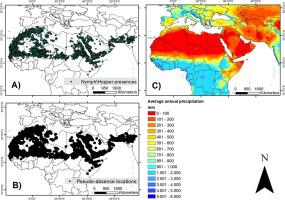Ecological Indicators ( IF 6.9 ) Pub Date : 2020-06-29 , DOI: 10.1016/j.ecolind.2020.106655 Diego Gómez , Pablo Salvador , Julia Sanz , José Luis Casanova

|
The desert locust is the world's most dangerous migratory pest according to the Food and Agriculture Organization of the United Nations (FAO), and its recession area extends over more than 30 countries. While promising assertions have been made to relate desert locust presences with remotely sensed soil moisture (SM), they have not yet been tested robustly in large-scale studies. The aim of this work was to evaluate the potential of soil moisture data to detect desert locust presences (solitarious nymphs) using the European Space Agency Climate Change Initiative Soil Moisture (ESA CCI SM) product from 1985 to 2017. Firstly, 5 machine learning algorithms were fitted using various pre-processing options and variable creation scenarios. Subsequently, the best performing models were fine-tuned using the k-fold cross validation technique and validate the results with an independent dataset taking random dates and locations. The best results were obtained by the weighted k-nearest neighbours (kknn) and random forest (rf) models. The kknn performance was ROC-AUC = 0.79, KAPPA = 0.61 and accuracy = 0.83; and the rf obtained a ROC-AUC = 0.91, KAPPA = 0.56 and accuracy = 0.81. In general, both models agreed that SM values above 0.11 m3/m3 led to increase the possibility to observe nymph of desert locust with a time delay between 35 and 79 days depending on the model. Furthermore, it was found that model performances increased when the time interval of the variables was smaller, so that we suggest the use of mean SM values over 4 days period to link presences and SM values. These results prove the validity of our methodology to identify favourable breeding areas by means of ESA CCI SM dataset using machine learning approaches over the entire recession area of desert locust, and it could be used in any of the affected countries for this pest. Future improvements in ESA CCI SM product (e.g. higher spatial resolution) may lead to improve model accuracies with monitoring and preventive purposes.
中文翻译:

使用32年土壤湿度数据大规模模拟沙漠蝗虫的存在
在沙漠蝗虫是根据联合国粮食和农业组织(FAO),世界上最危险的迁飞性害虫,其经济衰退的面积超过了30多个国家延伸。尽管已经做出了有前途的断言,将沙漠蝗虫的存在与遥感土壤水分(SM)相关联,但尚未在大规模研究中对它们进行有力的测试。这项工作的目的是使用1985年至2017年间使用欧洲航天局气候变化倡议土壤水分(ESA CCI SM)产品评估土壤水分数据检测沙漠蝗虫(食性若虫)的潜力。首先,进行5台机器学习使用各种预处理选项和变量创建方案来拟合算法。随后,使用k倍交叉验证技术对性能最佳的模型进行了微调,并使用具有随机日期和位置的独立数据集验证了结果。加权k最近邻(kknn)和随机森林(rf)模型获得了最佳结果。kknn性能为ROC-AUC = 0.79,KAPPA = 0.61,准确度= 0.83;rf得出ROC-AUC = 0.91,KAPPA = 0.56,准确度= 0.81。通常,两个模型都认为SM值高于0.11 m 3 / m 3导致根据模型的不同,观察沙漠蝗虫若虫的时间会延迟35到79天。此外,还发现,当变量的时间间隔较小时,模型性能会提高,因此我们建议使用4天期间的平均SM值来链接状态和SM值。这些结果证明了我们的方法通过ESA CCI SM数据集使用机器学习方法在沙漠蝗虫整个衰退区中识别有利繁殖区的方法的有效性,并且该方法可在任何受影响的国家中使用。ESA CCI SM产品的未来改进(例如更高的空间分辨率)可能会改善具有监视和预防目的的模型准确性。



























 京公网安备 11010802027423号
京公网安备 11010802027423号